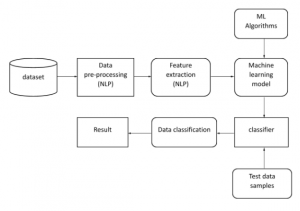Description
AI-based Movie Recommendation System
Abstract: –
AI-based Movie Recommendation– The success of the deep neural system has been achieved. recent challenging challenges in AI, image processing, and other fields as well as natural language understanding. As a suggestion Deep learning is a huge part of system innovation. Deep learning can be used in a variety of systems, including Movies. Speech recognition, book suggestions, and recommendations are just a few of the features available. On-demand video Deep learning is capable of resolving complex relationships. Many scientists employ deep neural networks in their study tasks. The majority of the time, the work necessitates complicated computing. In the system, two models are proposed. The recommendation algorithm is based on the film datasets. With the help of The authors discover a relationship between the user and the thing with the help of the user and the object them. Collaboration of current and historical data Filtering has been completed. There are two deep learning models used. These two models are complementary to one another. The data is used to train models. The anticipated rating is more precise than the previous method.
Objective: –
Movie recommendation systems can significantly improve the listening and search experience of a Movie library or Movie application. Algorithmic recommender systems have become inevitable due to increased access to digital content. In the Movie industry, there is just too many Movie for the user to navigate tens of millions of songs effectively. Since the need for satisfactory Movie recommendations is so high, the MRS (Movie recommendation systems) field is developing at a lightning speed. On top of that, the popularity of streaming services such as Spotify and Pandora shows that people like to be guided in their Movie choice and discover new tracks with the help of algorithms.
Introduction: –
Item and user interaction are both captured in the collaborative filtering process. It’s possible that the interaction is either implicit or explicit. In the RBM-like method, only user-user or item-item cooccurrence is captured, but user-item interaction is not. In a social tagging system, the content-based model is applied. The use of social tagging systems is quickly increasing. Many academics are working to improve recommendations by including social tagging. By employing contextual data that logically evaluates the item and user relevance, authors in [4] offered a natural likeness to address the tag uncertainty problem without the need for system setup. Author demonstrated that the planned natural likeness is naturally more exact than the current similarity using logical measures and measures. A content-based strategy is employed in a social tagging system. It’s unique to you.
The existing model of the system: –
A Novel Collaborative Filtering Model for Recommendation Systems Based on Deep Learning: The authors of this work [3] introduced a revolutionary deep learning technique.By comprehending a successful intelligent proposal, you can copy it. Previously, there were users and items. In the preliminary stage, Users and items are compared using low-dimensional vectors. independently discovered, which inserts the semantic data reflecting the relationship between the user and the item Throughout the forecast stage, a feed-forward neural system is utilized to reproduce the association between User and item.
Proposed model of the system: –
Cold start issues, sparsity, and scalability are all issues with existing collaborative filtering approaches. Although Matrix Factorization helps to some extent, it is unable to represent intricate relationships between rating matrices. By switching from scalar products to deep learning in classical Matrix Factorization, neural network matrix factorization analyses recommendations. Deep learning is used to solve these issues.

AI-based Movie Recommendation
System Requirements: –
Hardware
- OS – Windows 7, 8, and 10 (32 and 64 bit)
- RAM – 4GB
Software:
- Python
- Anaconda navigator
- Python built-in module
Conclusion: –
This paper examined various deep learning strategies for improving the recommender system’s recommendation quality. To create recommendations, collaborative filtering is chosen. Matrix factorization is used to achieve more collaborative filtering. A deep neural network is then used to implement collaborative filtering. This method establishes a link between the item and the user. The system then evaluates the past and present relationships between things and users. The focus is on creating end-to-end neural networks that take into account previous behavior. It is projected that deep learning would be used in a certain way. The proposed solution will be capable of overcoming the sparsity issue in the recommendation system.
References:-
[1]. Manoharan, Samuel. “Patient Diet Recommendation System Using K Clique and Deep learning Classifiers.” Journal of Artificial Intelligence 2, no. 02 (2020): 121-130.
[2]. Karunakaran, V. “A stochastic development of cloud computing-based task scheduling algorithm.” Journal of Soft Computing Paradigm (JSCP) 1, no. 01 (2019): 41-48.
[3] Fu, Mingsheng, Hong Qu, Zhang Yi, Li Lu, and Yongsheng Liu. “A novel deep learning-based collaborative filtering model for recommendation system.” IEEE transactions on cybernetics 49, no. 3 (2018): 1084-1096.
[4] Xu, Zhenghua, Oana Tifrea-Marciuska, Thomas Lukasiewicz, Maria Vanina Martinez, Gerardo I. Simari, and Cheng Chen. “Lightweight tag-aware personalized recommendation on the social
web using ontological similarity.” IEEE Access 6 (2018): 35590-
[5] Wang, Haoxiang, Guihuang Liang, and Xingming Zhang. “Feature regularization and deep learning for human resource recommendation.” IEEE Access 6 (2018): 39415-39421.
[6] Chen, Chih-Han, Maria Karvela, Mohammadreza Sohbati, Thaksin Shinawatra, and Christofer Toumazou. “PERSON—Personalized expert recommendation system for optimized nutrition.” IEEE transactions on biomedical circuits and systems 12, 1 (2017): 151-160.
[7] Jiang, Yangbangyan, Qianqian Xu, Xiaochun Cao, and Qingming Huang. “Who to ask: An intelligent fashion consultant.”



































































































































































































































































































































































































































































































































































































































































































































































































































































































































































































































































Customer Reviews
There are no reviews yet.